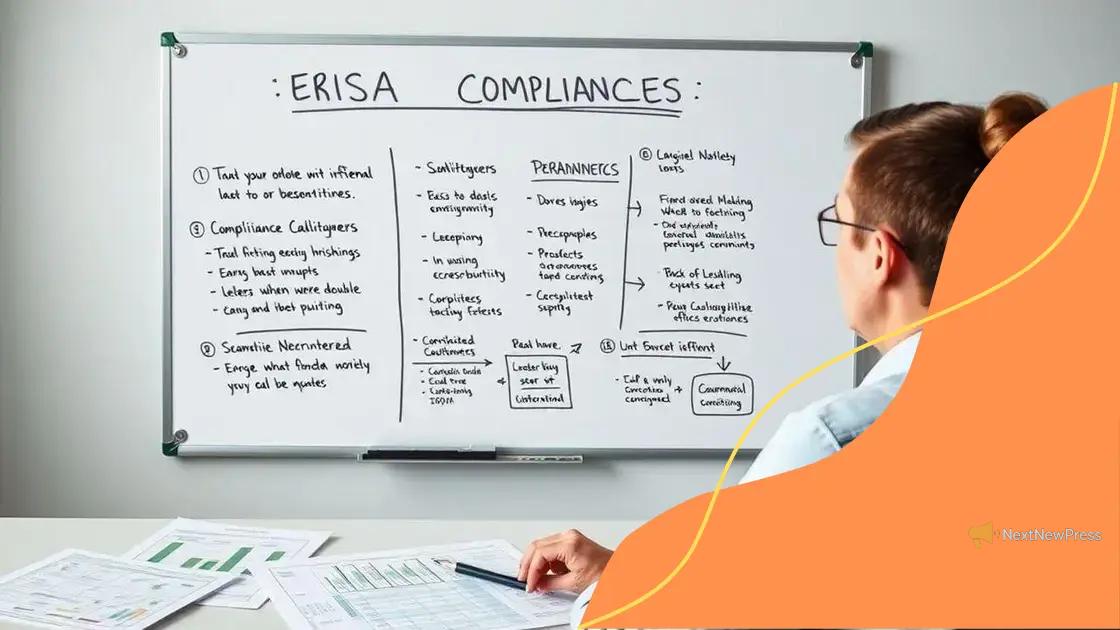Navigating ERISA regulations: simplify compliance today

Navigating ERISA regulations involves understanding key components such as disclosure requirements, fiduciary responsibilities, and maintaining compliance through proper recordkeeping and employee communication.
Navigating ERISA regulations can feel daunting, especially for those new to employee benefit plans. You might wonder, what do these regulations really mean for your organization? Let’s dive in and explore the essentials that could ease your compliance journey.
Understanding ERISA and its importance
Understanding ERISA and its importance is essential for anyone involved in employee benefits. The Employee Retirement Income Security Act, or ERISA, was established to protect the interests of employees by setting standards for pension and health plans. This law ensures that plans are managed fairly and that employees receive the benefits they deserve.
Key Features of ERISA
ERISA requires plans to provide participants with important information about plan features and funding. These features help ensure that employees are informed about their retirement and health benefits. Some key features include:
- Required disclosure of plan specifics.
- Standards for fiduciary responsibility.
- Protection for participants’ rights.
An important aspect of ERISA is its emphasis on accountability. Plan managers must adhere to strict guidelines and act in the best interest of the participants. This means they must make decisions based on the needs and benefits of employees. By following these guidelines, plans can avoid conflicts of interest and ensure that employees receive the promised benefits.
The Importance of Compliance
Compliance with ERISA helps protect both employees and employers. Employers gain trust from their employees when they adhere to these regulations. Additionally, complying with these rules can help avoid legal issues and financial penalties. Failing to comply can lead to costly repercussions, putting both employees and the organization at risk.
Moreover, understanding ERISA is crucial for employers when designing benefit plans. By being informed, employers can create retirement and health plans that not only meet legal requirements but also serve the employees’ best interests. This understanding fosters a positive workplace environment where employees feel valued and secure.
In conclusion, understanding ERISA and its importance goes beyond mere compliance. It builds a foundation of trust and accountability, ultimately benefiting both employees and employers.
Key components of ERISA regulations
Key components of ERISA regulations are crucial for understanding how employee benefit plans must operate. These regulations are designed to protect employee rights and ensure fair management of benefits. Organizations need to grasp these components to maintain compliance and provide adequate benefits.
Disclosure Requirements
One primary component of ERISA is the requirement for clear disclosure of plan information. Employees must receive:
- A summary plan description (SPD).
- Annual reports about the plan’s financial status.
- Updates on changes to benefits or funding.
This transparency helps employees understand their benefits and how the plan works, ensuring they are well-informed.
Fiduciary Responsibilities
Another vital aspect is the fiduciary responsibility imposed on plan managers. They are obligated to act in the best interests of plan participants. This means they must:
- Make decisions prudently and in a timely manner.
- Avoid conflicts of interest when managing the plan.
- Ensure investments are safe and profitable.
By adhering to these principles, fiduciaries protect employee benefits and maintain trust.
Additionally, ERISA regulations outline the rights and protections for participants. This includes the right to appeal denied claims and receive fair treatment. Employees can take legal action in case of violations, which holds employers accountable.
A strong understanding of these key components allows employers to create effective benefits plans that not only meet legal standards but also support their employees’ needs. When organizations align with ERISA regulations, they foster a positive work environment that enhances employee satisfaction.
Challenges in ERISA compliance

Challenges in ERISA compliance can often feel overwhelming for organizations. These challenges can arise from navigating complex regulations and ensuring that all aspects of employee benefit plans adhere to the law. Understanding these hurdles is essential for maintaining compliance and protecting the interests of both the organization and its employees.
Complex Regulations
One significant challenge is the complexity of ERISA regulations. These rules can be difficult to interpret and apply. Employers may find it hard to:
- Stay updated on regulatory changes.
- Understand the specific requirements for their plans.
- Interpret legal language and requirements accurately.
This complexity can lead to unintentional violations, which could result in legal issues or financial penalties.
Recordkeeping Requirements
Another area of concern involves stringent recordkeeping requirements. Organizations must maintain precise and detailed records of:
- Plan documents and amendments.
- Financial reports and disclosures.
- Participant information and claims.
Failing to keep accurate records can lead to non-compliance and accountability issues for the organization.
In addition, employee education is often overlooked. Many employees may not fully understand their benefits, which can lead to under-utilization of available resources. Companies must invest time and resources into educating employees about their rights and benefits under ERISA. This can be a challenge, especially in large organizations with diverse workforces.
Moreover, ensuring that all employees are treated fairly and consistently under benefit plans can be a daunting task. Misinterpretations and inconsistencies can cause distrust among employees, impacting morale and retention. Organizations need effective communication strategies to manage these challenges.
Best practices for navigating ERISA
Best practices for navigating ERISA can help organizations effectively manage compliance. Following these practices not only minimizes risks but also ensures that employee benefits are properly administered. Adopting these strategies is crucial in today’s regulatory environment.
Stay Informed
One of the best practices is to stay informed about ERISA regulations. This includes regularly updating knowledge on changing laws and guidelines. Employers should:
- Subscribe to industry newsletters and updates.
- Attend relevant workshops and training sessions.
- Engage with legal experts that specialize in employee benefits.
By keeping updated, organizations can anticipate changes and adjust their plans accordingly, avoiding potential pitfalls.
Implement Strong Recordkeeping Practices
Another effective strategy is to implement strong recordkeeping practices. Maintaining accurate records is essential for compliance with ERISA. Organizations should:
- Regularly audit benefit plans and records.
- Ensure all documentation regarding plan changes is up to date.
- Store records in an accessible format for easy reference.
Proper recordkeeping protects both the organization and its employees, providing clarity and accountability.
Clear communication is also vital. Organizations should routinely inform employees about their benefits and any changes. Providing resources, such as FAQs or workshops, can empower employees to understand their rights under ERISA.
Lastly, involve all stakeholders in the compliance process. This includes HR, finance, and legal teams. Working collaboratively enhances understanding and management of compliance efforts. Together, they can ensure that employee benefits not only meet legal standards but also address the needs of the workforce.
Resources for further guidance on ERISA
Resources for further guidance on ERISA are essential for employers navigating the complexities of regulations. Having access to reliable information can make a significant difference in compliance efforts. Various sources provide helpful insights into managing employee benefits effectively.
Government Websites
The first place to look for guidance is government websites. The Employee Benefits Security Administration (EBSA) offers extensive resources on ERISA, including:
- Fact sheets explaining key provisions.
- Guidance for plan administrators.
- FAQs addressing common concerns.
These resources can serve as a foundation for understanding the basic requirements and responsibilities under ERISA.
Professional Associations
Professional associations also provide valuable information. Organizations like the Society for Human Resource Management (SHRM) and the American Benefits Council offer:
- Webinars on current trends and regulations.
- Networking opportunities with other professionals.
- Publications that cover best practices in benefits administration.
Participating in these associations can keep companies informed about important updates and changes in the law.
Books and online courses are another great resource for in-depth knowledge. Many authors and experts publish materials focused on ERISA compliance. These can provide detailed analyses and case studies that help clarify complex topics.
Additionally, consulting with legal or benefits specialists can ensure that organizations are on the right path. Hiring experts can provide tailored advice and support in navigating the intricate landscape of ERISA regulations.
FAQ – Frequently Asked Questions about Navigating ERISA Regulations
What is ERISA?
ERISA stands for the Employee Retirement Income Security Act, which is a federal law that sets standards for pension and health plans in private industry.
What are the main components of ERISA regulations?
The main components include disclosure requirements, fiduciary responsibilities, and participant rights, all of which ensure that employee benefits are well-managed and transparent.
How can I stay compliant with ERISA?
You can stay compliant by regularly updating your knowledge on ERISA regulations, maintaining accurate records, and communicating clearly with employees about their benefits.
What resources are available for guidance on ERISA?
Resources include government websites like the Employee Benefits Security Administration (EBSA), professional associations, educational materials, and consultations with experts in employee benefits.





